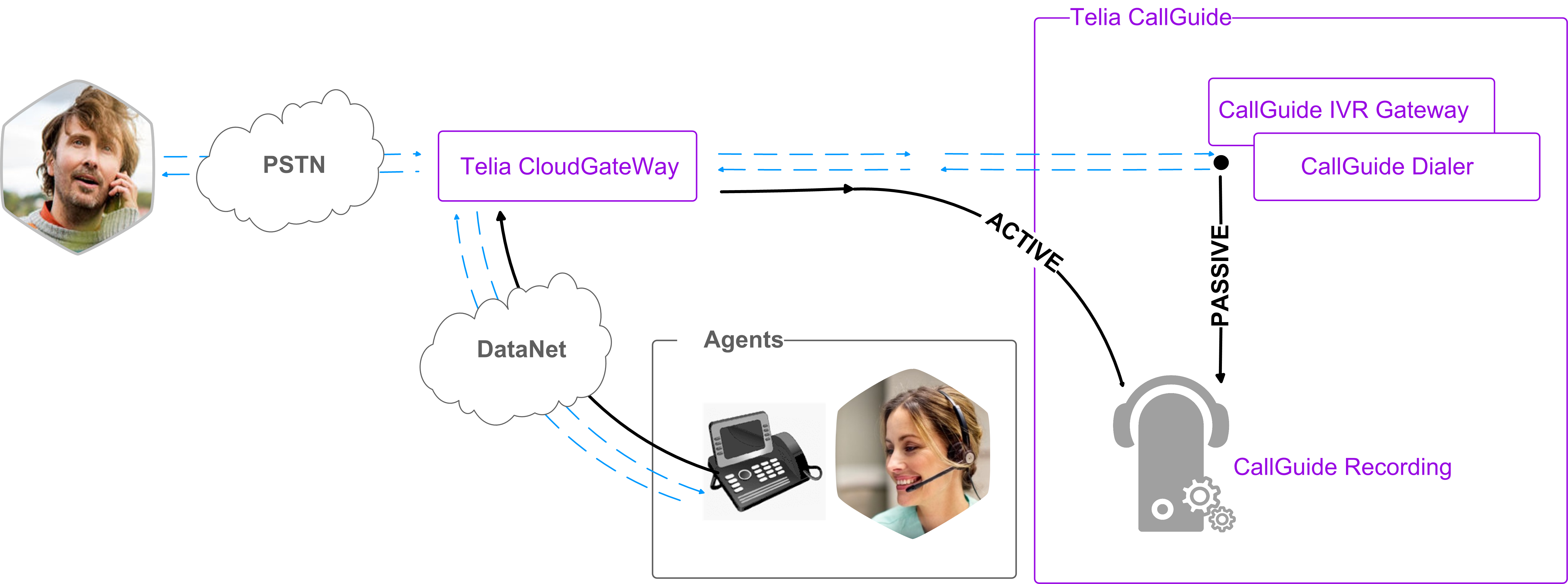ACE Recording uses two technical solutions, where main differences are which types of calls that can be recorded and how the VoIP calls' audio streams are handled.
- Passive Recording
The audio stream is sent to the recording equipment from a tap attached to the IVR. - Active Recording
A copy of the audio stream is sent from the user's phone to the recording equipment.

Recording rules, briefly described below, are mainly handled by Telia Company staff. However, included in Passive Recording is a Privacy control concept, where you can prevent recording of calls based on certain conditions, such as to never record calls to or from a specific user.
Passive Recording
Passive Recording is PBX independent and includes recording of all incoming calls from ACE IVR Gateway, as well as the campaign calls made via ACE Dialer.
- The recording rules, configured by Telia Company, can be based on the following parameters:
- Call type, such as incoming calls, conference calls, transferred calls and campaign calls using ACE Dialer. In some solutions, you can record outbound calls as well.
- Agent
- Extension location
- Campaign
- Contact data
- Time of the day
- Percentage
- If there is a rule based automatic recording in progress, and recording on demand is started via ACE Agent, the recordings will run in parallel. Both recordings are stored and can be found later by a search.
- During enquiry, the enquiry call in itself is not recorded. The agent’s customer call, which is on hold, is recorded.
- If the agent alternates between the customer and the called party during enquiry, only the agent’s call with the customer is recorded.
- When an internal conference (a call between customer, agent and the agent’s colleague) is recorded, both agents' calls are recorded. If one of the agents leave the conference, recording is terminated for that agent only. If the customer hangs up, the recording will continue until one of the agents hangs up, but no audio will be recorded, since only the customer audio passes through the recording equipment.
Active Recording
Active Recording can record all kinds of calls in Cisco UCM based solutions.
You can record calls handled via ACE Agent applications, or calls made directly to or from a specified extension.
When recording calls handled via Cisco UCM, the telephony device creates a copy of the call in progress and sends it to the recording equipment. This is why recording rules cannot be based on contact data in ACE, even if contact data is later retrieved for each recorded call. If calls are to be recorded automatically, you have the selection based on the following parameters:
- Agent
- Agent group
- Time of the day
- Percentage
If there is a rule based automatic recording in progress, and a recording is started manually via ACE Agent, no new recording is started. However, the recording in progress will be marked to show that the recording on demand has been requested.
When an internal conference (a call between customer, agent and the agent’s colleague) is recorded, both agents' calls are recorded. If one of the agents leave the conference, recording is terminated for that agent only. If the customer hangs up, the recording will continue until one of the agents hangs up.
Start and stop recording for various types of calls
If your solution has been configured to automatically record calls, a recording is started when the agent accepts a call. Normally, the recording is terminated when the call is ended.
- Campaign calls using ACE Dialer are not suitable for recording with Active Recording. For organisations using Active Recording and campaign telephony with ACE Dialer, we therefore recommend a dual recording solution, i.e. Passive Recording for recording campaign calls, and Active Recording for all other call types.
- When a call is transferred to another agent, the recording is stopped for the first agent, and a new recording is started for the second agent.
- When a call is parked, recording is terminated. Recording starts again when the call is retrieved. The call will thus create two recordings with the same contactID.
- If ACE Server is restarted, the behaviour for the recording varies somewhat depending on the technical solution:
- For Active Recording, the recording in progress continues.
- For Passive Recording, the recording is terminated. No new recordings are made until ACE Server is up and running again.
- If ACE Agent is terminated, the behaviour for the recording varies somewhat depending on the technical solution:
- For Active Recording, the recording in progress continues.
- For Passive Recording, the recording is terminated. No new recordings are made until ACE Agent is up and running again.
- The maximum length of a recording is set to 120 minutes to avoid situations where a recording continues through the night for an extension, just because the last call of the day was not terminated correctly.
Manual recording of an individual call
Recording of a call can be started manually by an agent or an administrator. In ACE Agent, recording can be started by clicking the recording button, i.e. Recording On Demand. See Handle call recording.

In the Monitor application, recording can be started for ongoing and future calls for a specific agent by an administrator.